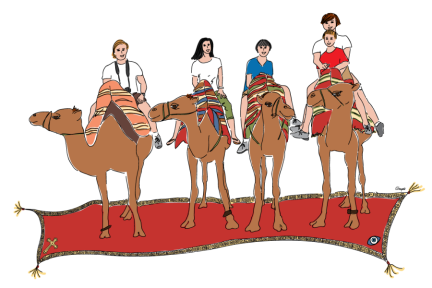Purchasing guidebooks and taking numerous photos of each place will help your children remember the landmarks; especially if you immediately make photo albums or photo books and document details. You are creating the memory for your child by having them metacognitively process their experience.
While I wouldn’t recommend only touring museums, castles and cathedrals, I definitely would build them into the itinerary as primary points of interest. A developmentally appropriate itinerary for elementary school aged children would strike a balance between cultural sightseeing of museums and monuments with time spent at the beach, children interactive museums and excursions or (theme) parks.
The latter might even be true for adults! It can be overwhelming to cram in too much intellectual information without a break. You have to give yourself time to process what you’ve visually experienced. Travel can be tiring and stressful if you don’t make time to rehydrate, relax, re-energize. Sometimes long, relaxing lunches can take care of the latter and give you that extra boost of energy to start touring/sightseeing again. We have been part lucky and part motivating for modeling for our sons how to travel energetically and keep up the pace. They never whined, slacked off or had to be coerced into doing something.
break. You have to give yourself time to process what you’ve visually experienced. Travel can be tiring and stressful if you don’t make time to rehydrate, relax, re-energize. Sometimes long, relaxing lunches can take care of the latter and give you that extra boost of energy to start touring/sightseeing again. We have been part lucky and part motivating for modeling for our sons how to travel energetically and keep up the pace. They never whined, slacked off or had to be coerced into doing something.
I remember when I was a child, I dragged along to things and knew I could get my parents’ or siblings’ attention to give in to me and cater to me. I worked it! But, our kids never tried this and since we never got the cycle started with them, they were troopers from the youngest of ages! It was why we were enthusiastic and willing to go on adventures almost yearly with them.
Of course, it helps to structure the day in a way that accommodates their needs, too. For example, we usually hit the road at 8 am after making sure they had a breakfast of peaches and yogurt and crackers for the car ride. This staved off hunger pains and kept everyone regular. We did heavy sightseeing from 8:00 am.-12:00, had lunch, did something recreational in the afternoon, maybe fit in a siesta with break time for their electronics, swimming, etc. and then hit the town again at nighttime. The biggest meal of the day was at night which is popular in Europe.
Doing your “homework” before a trip to get to know what your itinerary or “lay of the land” will be will help plan ahead. For us, it helped to ask questions/get tips from a similar-sized family who went to Greece a year before us. Smooth sailing!
© Gina Michalopulos Kingsley
More chapters like this are in the book A Magic Carpet Ride. Click on link below. Proceeds go to charity.https://www.amazon.com/dp/069271393X/ref=cm_sw_su_dp
Follow this lesson plan to build trip itineraries with your family:






















































